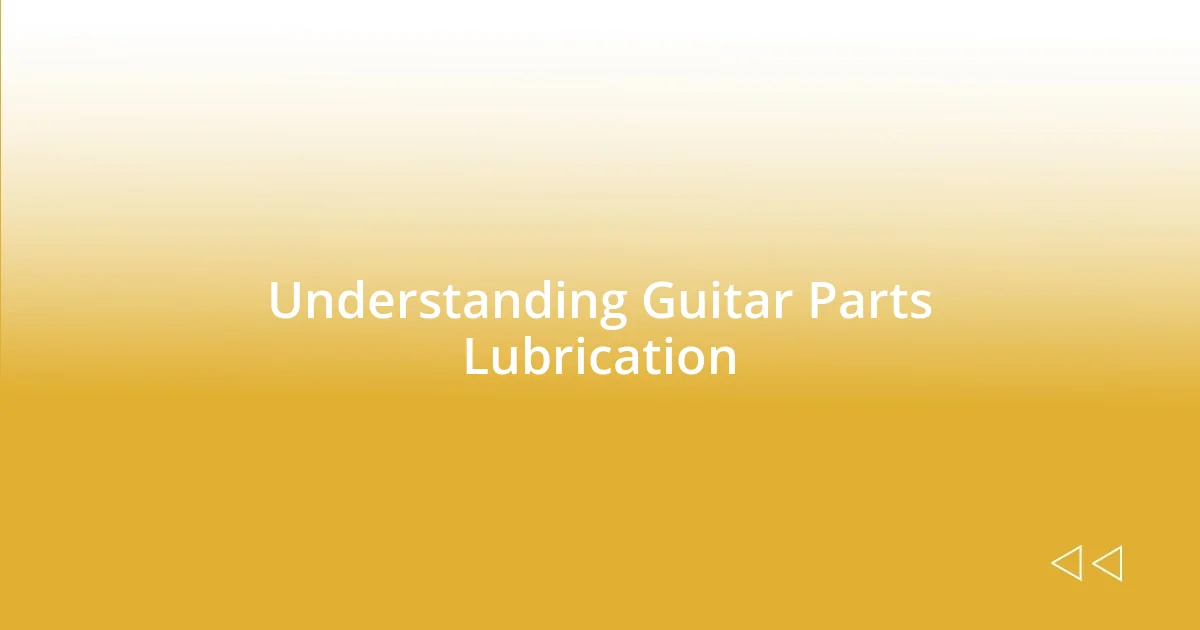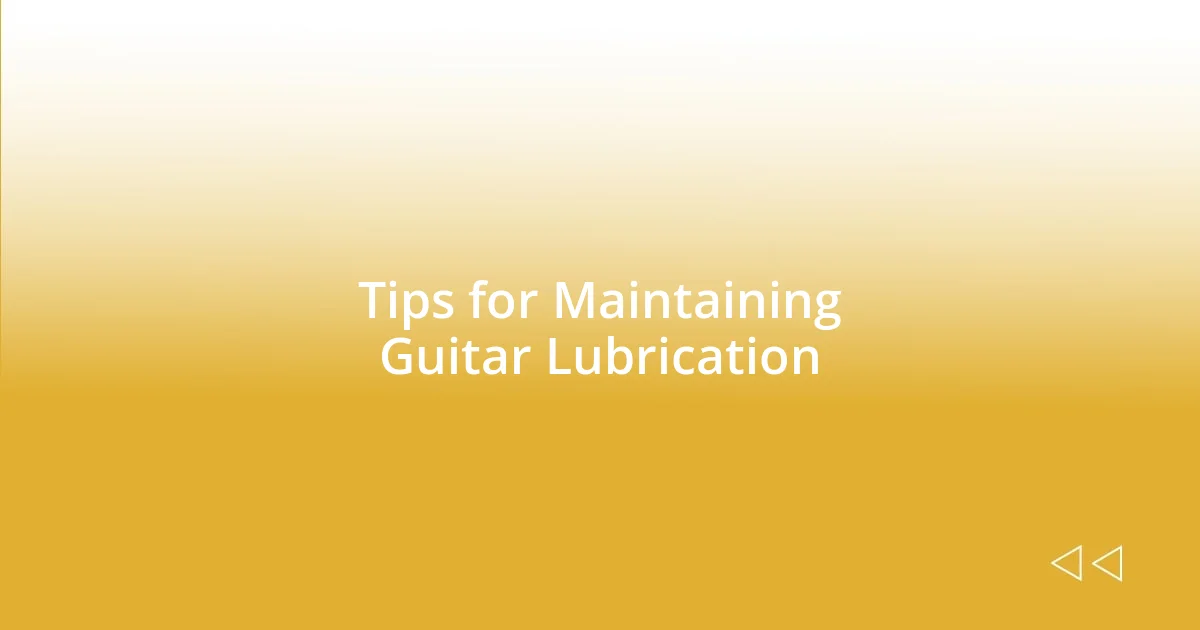Key takeaways:
- Regular lubrication of guitar parts enhances performance, prevents wear, and maintains sound quality, significantly improving the overall playing experience.
- Specific lubricants are recommended for different guitar components, such as graphite for nut slots, silicone spray for potentiometers, and Vaseline for bridges.
- Proactive maintenance and listening to your guitar’s needs can prevent serious issues, while seeking professional help is advisable for persistent problems or technical uncertainties.

Understanding Guitar Parts Lubrication
Lubricating guitar parts is essential for ensuring smooth performance and longevity. I still vividly remember the first time I felt the difference after applying a quality lubricant to my guitar’s tuning pegs—it was like unlocking a new level of playability. Have you ever struggled with a stiff string or a creaky bridge? That frustration fades away with proper lubrication.
When I think about the various guitar components, it becomes clear that different parts require specific types of lubrication. For instance, using a general-purpose oil on the nut can lead to unwanted residue buildup, affecting tone and playability. In my experience, a graphite pencil is an excellent choice for lubricating nut slots; it’s simple, effective, and prevents string binding with minimal fuss.
Regular maintenance, including lubrication, can significantly improve your guitar’s overall sound and performance. It’s surprising how many players overlook this crucial step. Have you ever considered how a little preventative care can save you from costly repairs down the line? From my perspective, investing just a few minutes for lubrication can lead to a noticeably enhanced playing experience, and I always encourage fellow musicians to make it a habit.

Importance of Lubrication for Guitars
Lubrication plays a pivotal role in maintaining the seamless functionality of your guitar. I vividly recall when I neglected this task—my guitar’s bridge started to stick, leading to frustrating moments while playing. It’s a subtle yet powerful reminder that a little care goes a long way. It’s like taking care of an old friend; with attention, they perform at their best.
When I lubricate the string saddles, it’s not just about preventing wear and tear; it enhances tone clarity too. There was a night when I spent hours tweaking my sound and was baffled until I realized the saddles needed some love. Once I applied the right lubricant, the difference was astounding. It’s those little adjustments that can turn a good performance into a memorable one, reminding me how important each part is in the overall equation.
Moreover, consistent lubrication of hardware like tuning pegs can prevent them from experiencing rust or corrosion. Just last week, I had a friend whose guitar had string issues after exposure to moisture due to untreated tuners. Learning from this, it’s clear that neglecting these components can have serious consequences, leading to bigger problems later. Keeping them well-maintained not only preserves playability but allows musicians to express themselves fully without interruption.
| Importance of Lubrication | Benefits |
|---|---|
| Enhances Performance | Improved playability and ease of use |
| Prevents Wear | Reduces friction, prolonging the life of parts |
| Maintains Sound Quality | Ensures clear and vibrant tones |
| Protects Against Corrosion | Safeguards metal components from rust |

Recommended Lubricants for Guitar Parts
When it comes to selecting the right lubricants for your guitar parts, I have found a few options that truly stand out. For instance, I’ve consistently turned to a high-quality graphite lubricant for nut slots. The first time I used it was a revelation; the strings glided effortlessly without binding. It was the sweet sound of relief, knowing I’d saved myself from hours of frustration on stage.
Here’s a list of recommended lubricants that I have personally used and trust:
- Graphite (Pencil): Perfect for nut slots and bridge saddles, offers a precise application.
- Silicone Spray: Great for potentiometers and switches, ensuring smooth operation.
- Vaseline or White Grease: Ideal for bridges and tuners, providing good protection without residue buildup.
- 3-in-One Oil: Versatile for general maintenance on metal parts; it penetrates well.
- Super Lube (Synthetic Grease): Excellent for long-term lubrication, especially under heavy use.
Trying these lubricants has allowed me to play with confidence, knowing that each part of my guitar can perform at its best. The emotional boost I get from knowing my instrument is well cared for is invaluable. Each strum feels purposeful because I understand my guitar is ready to deliver.

Step by Step Lubrication Process
To begin the lubrication process, I always ensure that my guitar is clean and dry. I remember the first time I skipped this step—I applied lubricant only to realize later that dust and grime created a sticky mess. Cleaning the parts beforehand makes the whole process smoother and more effective.
Next, I carefully apply the lubricant to specifically targeted areas, like the nut slots and bridge saddles. I often use a toothpick or a small brush for precision; it allows me to avoid over-applying. I can’t stress enough how important it is to avoid gunk buildup—my old guitar bridge taught me that lesson the hard way after I realized the sound was muffled due to excess grease.
Lastly, I always give the lubricant a moment to settle in before reassembling and restringing. Waiting patiently is so worth it! I’ve had times when I rushed this step, only to find that my strings were binding again. Trust me, that little pause pays off in enhanced performance and overall playability—those lovely fluid riffs are what make it all come together beautifully.

Tips for Maintaining Guitar Lubrication
Maintaining the right lubrication on your guitar doesn’t just enhance performance; it can also extend the life of essential parts. From my experience, checking and reapplying lubricant every couple of months has made all the difference. Have you ever plucked a string only to hear an unpleasant squeak? Regular maintenance helps me avoid those awkward moments during a jam session.
When it comes to applying lubricant, I often use the “less is more” approach. I remember a time I was too generous with a lubricant on my bridge—it created a mess that not only affected the sound but also made me question my judgment. Now, I cautiously apply just a dab using a precision tool, allowing me to maintain control without overwhelming the components. It’s amazing how just the right amount can transform the feel of my instrument.
Another tip I’ve picked up is to listen to my guitar. Yes, you read that right! If I notice my strings slipping or the action feeling off, it prompts me to check the lubrication right away. Over the years, I’ve learned that these small signs can lead to bigger issues if not addressed. Staying attuned to my guitar’s needs not only improves playability but also strengthens my bond with the instrument. How do you connect with your guitar?

Troubleshooting Lubrication Issues
Troubleshooting lubrication issues can feel a bit daunting at first, but I’ve found that a simple checklist can be a lifesaver. I recall an instance where my tuning pegs started slipping, and I thought it was a sign of something far worse. After a quick inspection, I discovered that the lubricant I used had dried up. A quick reapplication solved the issue, reminding me that sometimes the solution is just a step away.
If you’re hearing strange noises after lubrication, like creaking or grinding, it might be a sign that you’ve applied too much lubricant. I’ve been there—my heart sank when I realized my overzealous application turned my guitar into a squeaky toy during practice. To rectify this, I gently cleaned the area with a microfiber cloth, which not only improved the sound but also restored my confidence as a player.
When strings start binding and causing tuning instability, I’ve learned that it often points to inadequate lubricant in the nut and saddle. After experiencing the frustration of tuning issues mid-song, I decided to reevaluate my approach. Now, I make it a point to recheck these areas during regular maintenance. I may even ask myself, “Is it just the strings, or could it be my lubrication technique?” It’s amazing how staying proactive can turn a problematic situation into an opportunity for improvement.

When to Seek Professional Help
There are moments when taking matters into your own hands with guitar maintenance isn’t enough. If you find yourself facing persistent issues like buzzing frets or complete tuning instability, it might be time to seek professional help. I remember a time when I was stumped by a strange vibration that just wouldn’t go away, no matter what I tried. After finally enlisting a luthier, their expert touch not only revealed the underlying problem but also gave me peace of mind.
Another sign that calling in the pros is necessary is if you’re unsure about tackling technical aspects of lubrication. For instance, if the complexities of your guitar’s nut and saddle leave you scratching your head, I totally get it! The last thing you want is to cause more harm than good. Trust me; a skilled technician can bring a level of precision that can elevate your guitar’s performance beyond what I achieved during my more amateur attempts.
Don’t hesitate to reach out for help if your intuition tells you something’s amiss. I think we’ve all been there, feeling that nagging doubt about whether we’ve applied the right type or amount of lubricant. When I was uncertain after one lubrication session, I took a deep breath and went to consult a professional. The peace of mind that comes from knowing your instrument is in capable hands is worth its weight in gold.















